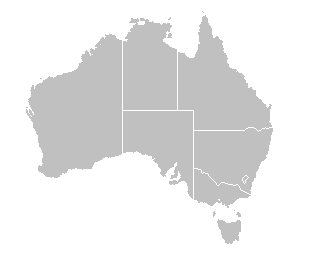Cricket in Australia
| Cricket in Australia | |
|---|---|
|
MCG hosting 2015 Cricket World Cup Final between Australia and New Zealand | |
| Country | Australia |
| Governing body | Cricket Australia |
| National team | Australia |
| First played | December 1803, Sydney, New South Wales |
| Registered players | 1,311,184 [1] |
National competitions | |
Club competitions | |
International competitions | |
Audience records | |
| Single match |
Test (overall): 350,524 – Australia v England, 3rd Test 1936/37, Melbourne Cricket Ground Test (day): 91,092 – Australia v England, Day 1 (26 December), 4th test 2013/14, Melbourne Cricket Ground ODI: 93,013 – Australia v New Zealand, 29 March 2015, 2015 Cricket World Cup Final, Melbourne Cricket Ground |
Cricket is one of the most popular sports in Australia at international, domestic and local levels. Unlike most other popular sports, cricket generates equal interest in all regions of the nation, and is therefore often referred to as Australia's national sport. The peak administrative body for both professional and amateur cricket in Australia is Cricket Australia.
A record 1,311,184 people played cricket across Australia in 2015-16, an 8.5 per cent increase on 2014-15 – placing cricket at No.1 as the current top participation sport in Australia. Women participation also reached record figures in 2015-16, growing nine percent to 314,936 players.[1] According to Cricket Australia's annual report of 2014-15, 1,208,360 Australians played formal, organised cricket during the year, an increase of nine percent over the previous year.[2] Separately, official audience data shows that 93.6% of Australians watched at least some cricket on TV in 2010–11 calendar year.[3]
History
1803–1939
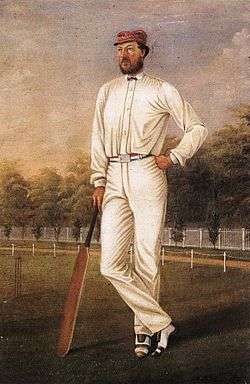
Cricket has been played in Australia for over 210 years. The first recorded cricket match in Australia took place in Sydney in December 1803 and a report in the Sydney Gazette on 8 January 1804 suggested that cricket was already well established in the infant colony. Intercolonial cricket in Australia started with a visit by cricketers from Victoria to Tasmania in February 1851.[4] The match was played in Launceston on 11–12 February with Tasmania winning by 3 wickets.[5]
The first tour by an English team to Australia was in 1861–62, organised by the catering firm of Spiers and Pond as a private enterprise. A further tour followed in 1863–64, led by George Parr and was even more successful than the last.[6]
In 1868, a team consisting of Aboriginal cricketers became the first Australian team to tour England. The team played 47 matches, winning 14, drawing 19 and losing 14. The heavy workload and inclement weather took its toll with King Cole contracting a fatal case of tuberculosis during the tour.[7]
Further tours by English teams took place in 1873–74 (featuring the most notable cricketer of the age W. G. Grace) and 1876–77.[6] The 1876–77 season was notable for a match between a combined XI from New South Wales and Victoria and the touring Englishmen at the Melbourne Cricket Ground played on 15–19 March. This match, later to be recognised as the first Test Match, was won by Australia by 45 runs thanks mainly to an unbeaten 165 by Charles Bannerman. The result of this match was seen by Australians and Englishmen as a reflection of the rising standard of Australian cricket.[8]
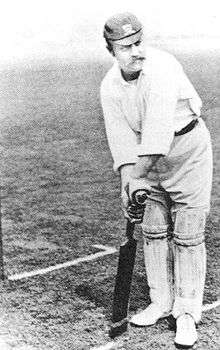
.
The rising standards of Australian cricket was further established during the first representative tour of England in 1878. A return visit in 1878–79 is best remembered for a riot and by the time Australia visited England in 1880, playing the first Test in England at The Oval, a system of international tours was well established.[6] A famous victory on the 1882 tour of England resulted in the placement of a satirical obituary in an English newspaper, The Sporting Times. The obituary stated that English cricket had died, and the body will be cremated and the ashes taken to Australia. The English media then dubbed the next English tour to Australia (1882–83) as the quest to regain The Ashes.[9] The Sheffield Shield, the premier first-class cricket competition in Australia, was established in 1892 by the Australasian Cricket Council, the first attempt at a national cricket board.[4]
The era from the mid-1890s to World War I has been described as Australian cricket's golden age. This era saw the emergence of players such as Monty Noble, Clem Hill and in particular Victor Trumper, who was idolised by the Australian public.[10] It also saw the emergence of the first women's cricket club in the colonies, captained by Lily Poulett-Harris . The Great War led to the suspension of both international and Sheffield Shield cricket and the enlistment of many cricketers in the AIF.[4] After the war, a team consisting of cricketers enlisted in the AIF toured the United Kingdom.[6]
International cricket recommenced with a tour by a weakened England team in 1920–21. The strong Australian team, led by Armstrong and with a bowling attack spearheaded by Gregory and Ted McDonald won the series 5–0, the first time this was achieved in an Ashes series.[4] Don Bradman, born in Cootamundra and raised in Bowral was 20 when he made his Test debut in the first Test of the 1928–29 series against England.[11] He would hold the records for the highest individual Test innings and the most centuries in Test cricket and when he retired in 1948 he had the highest Test batting average, the last a record he still holds. He scored 117 first class centuries, still the only Australian to score a century of centuries and was knighted for services to cricket.[11]
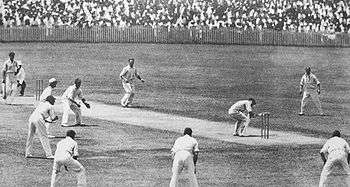
The Bodyline controversy began when Bradman toured England with the Australian team in 1930. Bradman scored heavily, 974 runs at an average of 139.14 including a then world record 334 at Leeds, two other double centuries and another single.[6] Watching these displays of batting was Douglas Jardine, playing for Surrey. Following discussions with other observers such as Percy Fender and George Duckworth, he developed a tactic to limit the prodigious run scoring of Bradman and the others.[12] The tactic, originally called fast leg theory and later called bodyline involved fast short pitched bowling directed at the batsman's body and a packed leg side field. Appointed captain of England for the 1932–33 series in Australia, Jardine was able to put these theories into practice. Combined with bowlers of the speed and accuracy of Harold Larwood and Bill Voce, the tactic required batsmen to risk injury in order to protect their wicket. In the third Test in Adelaide, Larwood struck Australian captain Bill Woodfull above the heart and fractured wicket-keeper Bert Oldfield's skull.[13]
In December 1934, the Australian women's team played the English women in the first women's Test match at the Brisbane Exhibition Ground. Despite a 7 wicket haul to Anne Palmer in the first innings, the English women were too strong and won by 9 wickets.[14]
1945–1969
Once again, war brought a stop to Shield and Test cricket as Australia mobilised for World War II. Immediately after the end of the war in Europe in 1945, an Australian Services XI played a series of Victory Tests in England. The team was captained by Lindsay Hassett and it saw the emergence of the charismatic all-rounder Keith Miller. The series was drawn 2–2.[15] After the retirement of Bradman in 1948, Hassett, Miller and all-rounder Ray Lindwall formed the nucleus of the Australian team. They were later joined by leg spinning all-rounder, Richie Benaud and batsman Neil Harvey.
By the 1958–59 series, Benaud was captain of the Australian side and managed to recover the Ashes. The 1960–61 series at home against the West Indies was widely regarded as one of the most memorable. A commitment by Benaud and his West Indian offsider Frank Worrell to entertaining cricket revived lagging interest in the sport.[16] The gripping series, including the first tied Test, saw Australia win 2–1 and become the inaugural holders of the newly commissioned Frank Worrell Trophy. The West Indian team was held in such affection that a ticker-tape parade in their honour prior to their departure from Australia attracted a crowd of 300,000 Melburnians to wish them farewell.[17]
In the late 1950s and early 1960s, there was an ongoing controversy regarding illegal bowling actions. A number of bowlers, Australian and international were accused of throwing or "chucking" over this period including the South Australian pair of Alan Hitchcox and Peter Trethewey and New South Welshman, Gordon Rorke.[4] The controversy reached a high point when Ian Meckiff was recalled to the Australian team for the first Test of the 1963–64 series against South Africa. Called on to bowl his first over, he was no-balled 4 times by umpire Colin Egar for throwing before being removed from the attack by his skipper, Benaud. As a consequence, Meckiff retired from all levels of cricket after the match and Egar received death threats from persons aggrieved at his call.[18]
1970–present
The 1970s saw players and administrators once again come into conflict. Poor scheduling saw Australia visit South Africa immediately after a tour to India in 1969–70. This would be the last tour to South Africa prior to the application of international sporting sanctions designed to oppose the policy of apartheid. The tired Australians came across a very strong South African team in conditions vastly different from the subcontinent, and were subsequently beaten 4–0. A request by the Australian Cricket Board for the players to play a further match in South Africa was met with resistance by the players, led by the captain, Bill Lawry.[19] During the following home series against England, Lawry was sacked as captain and replaced by the South Australian batsman, Ian Chappell. Lawry remains the only Australian captain to be sacked in the middle of a Test series.[19] Chappell, part of a younger and more assertive generation, saw the board's treatment of Lawry as disgraceful and made a pledge to never allow himself to be placed in the same situation.
Greg Chappell, Ian's younger brother, succeeded him as captain in 1975–76 and led the Australian team in the Centenary Test in Melbourne in March 1977. A celebration of 100 years of Test cricket, Australia won the Test by 45 runs, the precise result of the corresponding game 100 years earlier.[20]
While Australian cricket celebrated, the Australian media tycoon Kerry Packer was making plans to wrest away the television rights for Australian cricket. During the 1977 Ashes tour, the cricket world became aware that Packer had signed 35 of the world's top cricketers for a series of matches, including 18 Australians, 13 of whom were part of the tour party.[21] World Series Cricket, as the breakaway group was known split Australian cricket in two for nearly three years. Former Australian captain, Bob Simpson was recalled from retirement to lead an inexperienced team in a home series against India in 1977–78, won 3–2 and then a tour to the West Indies, marred by an ugly riot.[4] For the 1978–79 Ashes series, he was replaced by the young Victorian, Graham Yallop. The subsequent thrashing, a 5–1 victory for England, and the success of World Series Cricket forced the Australian Cricket Board to concede on Packer's terms.[4]
The settlement between the ACB and WSC led to the introduction of a series of innovations including night cricket, coloured clothing and an annual limited overs tri-series called the World Series Cup. It also signalled the return of the champion cricketers Greg Chappell, Dennis Lillee and Rod Marsh. Their retirement at the end of the 1983–84 season was quickly followed by a series of tours to South Africa by a rebel Australian team in breach of the sporting sanctions imposed on the apartheid regime. The combined effect was to leave Australian cricket at its nadir under reluctant captain, Allan Border, losing Test series at home (2–1) and away (1–0) to New Zealand in 1985–86.[22]
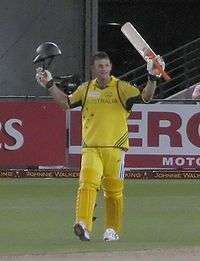
The long road back for Australian cricket started in India in 1986–87. Border, along with Bob Simpson in a new role as coach, set out to identify a group of players that a team could form around.[23] These players showed some of the steel necessary in the famous tied Test at the M. A. Chidambaram Stadium in Chennai. Returning to the subcontinent for the World Cup in 1987, Australia surprised the cricket world by defeating England at Eden Gardens in Kolkata to win the tournament with a disciplined brand of cricket.[24] By the 1989 Ashes tour, the development of players such as Steve Waugh and David Boon and the discovery of Mark Taylor and Ian Healy had reaped rewards. The 4–0 drubbing of England was the first time since 1934 that Australia had recovered the Ashes away from home and marked the resurgence of Australia as a cricketing power.[25] Australia would hold the Ashes for the next 16 years.[26]
The most successful leg spin bowler in the history of the game, Shane Warne, made his debut in 1991–92 in the third Test against India at the Sydney Cricket Ground. He had an undistinguished Test debut, taking 1/150 off 45 overs, and recording figures of 1/228 in his first Test series. From this modest beginning, Warne dominated Australian cricket for 15 years, taking 708 wickets at an average of 25.41.[27] When the fast medium bowler, Glenn McGrath was first selected in the Australian team for the Perth test against New Zealand in 1993–94, the core of a highly successful bowling attack was formed. In 1994–95, under new captain Taylor, the Australians defeated the then dominant West Indies in the Caribbean to recover the Frank Worrell Trophy for the first time since 1978 and staked a claim to be considered the best team in the world.[28]
Following a disappointing World Cup at home in 1992, Australia then entered a run of extraordinarily successful World Cup campaigns; runners up to Sri Lanka in 1996 in the subcontinent, fighting back after early setbacks to win in England in 1999 and unbeaten on their way to another victory in South Africa.[29] The change in captain from Taylor to Steve Waugh made little difference in the success of the Australian team. Waugh made a slightly rocky start to his term as captain, drawing 2–2 with the West Indies in the Caribbean and losing to Sri Lanka 1–0 away. A victory in the Australian team's first ever Test match against Zimbabwe was the start of an unparalleled 16 Test winning streak. The streak was finally ended in 2001 in Kolkata with a remarkable victory by India after being asked to follow-on. For Waugh, India would remain unconquered territory.[30]

Australia's success was not without its detractors. Accusations of racism were made against the Australian team, one incident leading to a suspension for Darren Lehmann in 2003.[31] Contacts between Warne and batsman Mark Waugh and illegal bookmakers, at first kept under cover by the ACB, were later revealed by the Australian press, sparking accusations of hypocrisy given Australian cricket's earlier attitude toward match fixing allegations.[32] Warne would later be suspended from all forms of cricket for 12 months after testing positive to banned diuretics hydrochlorothiazide and amiloride.[32] The brand of cricket played by the Australian team was praised for its spirit and aggressiveness but critics charged that this aggressive approach led to ugly sledging incidents such as the confrontation between McGrath and West Indian batsman, Ramnaresh Sarwan at the Antigua Recreation Ground in 2003.[33] Tasmanian batsman Ricky Ponting would admit to an alcohol problem after incidents in India and in Sydney.[34]
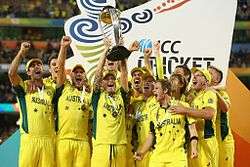
A rehabilitated Ponting would succeed Waugh as captain in 2004. While injured for most of the 2004–05 series against India, his team under acting captain Adam Gilchrist defeated India in India, the first Australian series win in India since Bill Lawry's team in 1969–70. A 2–1 defeat in the 2005 Ashes series in England was quickly avenged at home with a 5–0 thrashing of England in 2006–07. The whitewash was the first in an Ashes series since Warwick Armstrong's team in 1920–21.[35] Following the series, the successful bowling combination of McGrath and Warne retired from Test cricket, with a record that was hard to match. Australia won the 2007 Cricket World Cup under Ricky Ponting in the Caribbean and were unbeaten through the tournament. Australian cricketer Matthew Hayden scored the most runs in the tournament. The finals happened to be Glenn McGrath's last match and he was also the highest wicket taker of the tournament and the player of the tournament.
The 2015 Cricket World Cup was jointly hosted by Australia and New Zealand from 14 February to 29 March 2015. Fourteen teams played 49 matches in 14 venues, with Australia staging 26 games at grounds in Adelaide, Brisbane, Canberra, Hobart, Melbourne, Perth and Sydney. Australia defeated New Zealand by 7 wickets to win their fifth ICC Cricket World Cup in front of a record crowd of 93,013. The winning captain Michael Clarke, retired from ODIs with immediate effect after the final match.[36]
International cricket

The Australian national team is one of the most successful teams in international cricket. Along with England, Australia was recognised as one of the founder nations of the Imperial Cricket Conference, later the International Cricket Council. Australia generally plays a test series against a visiting team, and a one-day series between two other teams at home each summer, and tours overseas for the remainder of the year
Test cricket
On 15 March 1877, an Australian representative team played England in what would later be recognised as the first Test match. They are the most successful Test cricketing nation, with a higher percentage of won matches than any other nation.[37]
In Test cricket, the Australian team compete for various trophies and championships. The ICC Test Championship is an international competition run by the ICC for the 10 teams that play Test cricket. The competition is notional in the sense that it is simply a ranking scheme overlaid on all international matches that are otherwise played as part of regular Test cricket with no other consideration whatsoever.[38]
The most famous among all these trophies is The Ashes, which was played for the first time in 1882 between Australia and England. Other bilateral trophies have generally been named after the great players from the two competing nations.
| Name of the trophy | Opponent | First played |
|---|---|---|
| ICC Test Championship | All test teams | 2003 |
| The Ashes | | 1882 |
| Frank Worrell Trophy [39] | | 1960-61 |
| Trans Tasman Trophy [40] | | 1985-86 |
| Border-Gavaskar Trophy [41] | | 1996 |
| Warne-Muralidaran Trophy [42] | | 2007-08 |
Venues
There have been only nine Test match venues in Australia since the first Test match in 1877. Three of the nine venues are no longer used for test matches.
| Name of the stadium | Capacity | City | State | First used | Opponent |
|---|---|---|---|---|---|
| Melbourne Cricket Ground | 100,024 | Melbourne | Victoria | 15 March 1877 | |
| Sydney Cricket Ground | 48,000 | Sydney | New South Wales | 17 February 1882 | |
| Adelaide Oval | 53,583 | Adelaide | South Australia | 12 December 1884 | |
| Brisbane Exhibition Ground | 25,490 | Brisbane | Queensland | 30 November 1928 | |
| Brisbane Cricket Ground (The Gabba) | 42,000 | Brisbane | Queensland | 27 November 1931 | |
| WACA Ground | 20,000 | Perth | Western Australia | 11 December 1970 | |
| Bellerive Oval | 19,500 | Hobart | Tasmania | 16 December 1989 | |
| TIO Stadium | 14,000 | Darwin | Northern Territory | 18 July 2003 | |
| Cazaly Stadium | 13,500 | Cairns | Queensland | 25 July 2003 | |
Grounds no longer used for test matches
One Day Internationals
The Australian team took part in the first one day international on 5 January 1971, once again also against England at the Melbourne Cricket Ground. Since then, the team has maintained a good record in one day internationals, winning five Cricket World Cups, more than any other national team.
Following the end of World Series Cricket, from 1979–80 the Australian season featured a triangular series of one day internationals, featuring the Australian team and two touring teams. The first incarnation of this tournament was called the World Series Cup and included night cricket, coloured uniforms and a white ball. In 1994–95, the tournament included an Australia A cricket team, due to the perceived weakness of the invited Zimbabwe team. For the 1996–97 season, the World Series Cup was replaced by a series of tournaments named after a major sponsor, including the Carlton and United Series, the VB Series and the Commonwealth Bank Series. The successor series followed a similar format.
Australia and New Zealand co-hosted the 1992 Cricket World Cup, and the 2015 Cricket World Cup. In 1992, for the first time, the tournament featured the innovations already common in Australian one-day matches such as night cricket and coloured clothing. The tournament featured nine nations, expanded to include a South African team recently admitted back into world cricket. Australia despite starting firm favourites,[43] performed poorly, failing to make the semi - final stage. Pakistan defeated England in the final in front of 87,182 spectators at the Melbourne Cricket Ground.[44]
The 2015 Cricket World Cup was the 11th Cricket World Cup, jointly hosted by Australia and New Zealand from 14 February to 29 March 2015. Fourteen teams played 49 matches in 14 venues, with Australia staging 26 games at grounds in Adelaide, Brisbane, Canberra, Hobart, Melbourne, Perth and Sydney.[45] The final match of the tournament took place at the Melbourne Cricket Ground between co-hosts New Zealand and Australia in front of a record crowd of 93,013.[36]

Women's cricket
There are currently 290,566 female participants in cricket. The Australia national women's cricket team competes internationally and has won the Women's Cricket World Cup 5 times, more than any other team.[46] As in men's cricket, Australia and England were the first two women's Test nations, playing in the inaugural women's Test in Brisbane in 1934. Australia compete with England for the Women's Ashes, a cricket bat symbolically burned prior to the 1998 test series. The Australian team also compete in the Rose Bowl series, a series of one-day internationals against New Zealand.
Domestic cricket
On a domestic level, each of the six states has a cricket team which competes in two separate competitions over summer:
- A four-day first-class competition known as the Sheffield Shield
- A one-day competition, known as the Matador Cup
Moreover, eight city-based franchises compete in the domestic Twenty20 competition known as Big Bash League. The Big Bash League replaced the previous competition, the KFC Twenty20 Big Bash in 2011.
Local club cricket is also popular, as well as social cricket which includes variations such as backyard and beach cricket.
First Class cricket
The Sheffield Shield is the domestic first-class cricket competition in Australia. It was established in 1892 using a bequest of ₤150 provided by Lord Sheffield for the improvement of Australian cricket and was originally named the Sheffield Shield in recognition. When established, the competition included the colonies (later states) of New South Wales, South Australia and Victoria. Queensland was admitted to the Shield competition for the 1926–27 season, Western Australia in 1947–48 and Tasmania in 1977–78.
In 1999, the Australian Cricket Board (now Cricket Australia) announced a 4-year sponsorship deal which included renaming the Sheffield Shield to the Pura Milk Cup, then to the Pura Cup the following season. As of the 2008–09 season, the title has reverted to its original name.
At the end of the 2006–07 season, all participating teams have won at least one Sheffield Shield/Pura Cup, with New South Wales the most successful state with 44 wins and Tasmania winning their first in 2006–07.
One Day cricket
The Matador BBQs One Day Cup is the domestic List A cricket (limited overs cricket) competition in Australia. It was established in 1969–70 and featured the state teams and a team from New Zealand. Originally a knock-out tournament, the format and name has changed several times since inception depending on the naming rights sponsor.
New Zealand withdrew from the competition after the 1974–75 season. The Canberra Comets, a team from the Australian Capital Territory were included for three seasons from 1997–98 to 1999–2000. At the end of the 2006–07 season, Western Australia has been the most successful state with 11 wins while South Australia and Tasmania have won two each.
In 2013, the format changed and all matches were held in Sydney at various grounds. It was broadcast live on GEM. The whole competition was held in the month of October, prior to the Sheffield Shield.
Twenty20 cricket
The KFC Big Bash League or BBL in short, is the Australian domestic Twenty20 cricket tournament, which was established in 2011. The Big Bash League replaced the previous competition, the KFC Twenty20 Big Bash, and features eight city-based franchises, instead of the six state-based teams which had competed before. Each state's capital city features one team, with Sydney and Melbourne featuring two.
BBL matches are played in Australia during the summer in the months of December and January. It is now placed ninth in the list of most attended sports leagues in the world with respect to average crowd per match (2015–16 season).[47][48]
Women's cricket

The founding mother of women's cricket in Australia was the young Tasmanian, Lily Poulett-Harris, who captained the Oyster Cove team in the league she created in 1894. Lily's obituary, from her death a few years later in 1897, states that her team was almost certainly the first to be formed in the colonies . Following this, the Victoria Women's Cricket Association was founded in 1905 and the Australian Women's Cricket Association in 1931. The current competition is run by the Women's National Cricket League.
The Women's National Cricket League is the domestic women's cricket competition in Australia. The first national competition in Australia was the Australian Women's Cricket Championships, an annual two-week tournament established in 1930–31. The championships were replaced by the league format in 1996–97. Victoria and New South Wales have been the most successful teams.
Club Cricket
Club cricket is popular and the first step for players looking to be selected for their state and national teams. Each state association has a peak club cricket championship variously known as 'district' or 'grade' cricket:
- Victorian Premier Cricket
- Sydney Grade Cricket
- South Australian Grade Cricket League
- Queensland Cricket Association
- Western Australian Grade Cricket
- Tasmanian Grade Cricket
International grounds
Nineteen different grounds in Australia have been used for international cricket (Tests, ODIs and Twenty20 Internationals). Five were only used once, during the 1992 World Cup, while three (all in Tasmania) only hosted games during 1980s World Series Cups. The main six used are:
| Name of the stadium | Capacity | City | State | First used | Opponent |
|---|---|---|---|---|---|
| Melbourne Cricket Ground | 100,024 | Melbourne | Victoria | 15 March 1877 | |
| Sydney Cricket Ground | 48,000 | Sydney | New South Wales | 17 February 1882 | |
| Adelaide Oval | 53,583 | Adelaide | South Australia | 12 December 1884 | |
| Brisbane Cricket Ground (The Gabba) | 42,000 | Brisbane | Queensland | 27 November 1931 | |
| WACA Ground | 20,000 | Perth | Western Australia | 11 December 1970 | |
| Bellerive Oval | 19,500 | Hobart | Tasmania | 16 December 1989 | |
Other grounds which have been used for Test cricket are:
| Name of the stadium | Capacity | City | State | First used | Opponent |
|---|---|---|---|---|---|
| Brisbane Exhibition Ground | 25,490 | Brisbane | Queensland | 30 November 1928 | |
| TIO Stadium | 14,000 | Darwin | Northern Territory | 18 July 2003 | |
| Cazaly Stadium | 13,500 | Cairns | Queensland | 25 July 2003 | |
Grounds which have been used for One Day Internationals only are:
| Name of the stadium | Capacity | City | State | First used | Team 1 | Team 2 |
|---|---|---|---|---|---|---|
| TCA Ground | 8,000 | Hobart | Tasmania | 10 January 1985 | | |
| NTCA Ground | 10,000 | Launceston | Tasmania | 2 February 1986 | | |
| Devonport Oval | 14,000 | Devonport | Tasmania | 3 February 1987 | | |
| Harrup Park | 10,000 | Mackay | Queensland | 28 February 1992 | | |
| Eastern Oval | NA | Ballarat | Victoria | 9 March 1992 | | |
| Manuka Oval | 12,000 [49] | Canberra | Australian Capital Territory | 10 March 1992 | | |
| Berri Oval | NA | Berri | South Australia | 13 March 1992 | | |
| Lavington Sports Ground | 20,000 | Albury | New South Wales | 18 March 1992 | | |
| Ethiad Stadium | 53,359 | Melbourne | Victoria | 16 August 2000 | | |
The only ground in Australia which has been used exclusively for the Twenty20 Internationals:
| Name of the stadium | Capacity | City | State | First used | Team 1 | Team 2 |
|---|---|---|---|---|---|---|
| ANZ Stadium | 82,500 | Sydney | New South Wales | 1 February 2012 | | |
| Simonds Stadium | 27,000 | Geelong | Victoria | 19 February 2017 |
Cricket in Australian culture
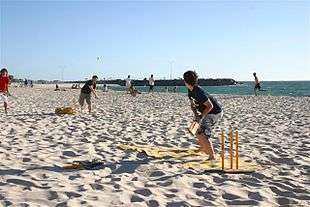
In 2007, The Age reported that a survey by Sweeney Sports had found that 59% of the Australian public have an interest in cricket, second to none.[50] Cricket is often known as Australia's national sport due to its equal popularity in all parts of the country. Cricket is also a mass participation sport in Australia: a census conducted on behalf of Cricket Australia found that in the 2003–04 season there were 471,329 participants in Australian cricket programmes and competitions, including 47,780 female participants.[51]
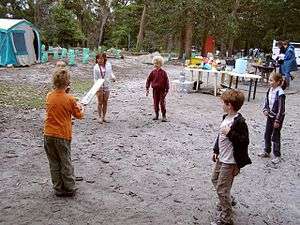
In 2015-16, a record 1,300,000 Australians played formal, organised cricket during the year, an increase of nine per cent over the previous year, making cricket Australia’s biggest participant sport.[2]
The position of Australian Test cricket captain is regarded as one of the most important roles in Australian sport. It is often said that in Australia the office of Test captain is second in stature behind the office of Prime Minister.[52][53][54] Reflecting this community perception, three Australian cricket captains have been named as Australian of the Year by the National Australia Day Council; Allan Border in 1989, Mark Taylor in 1999 and Steve Waugh in 2004.[55] In addition, Steve Waugh has been nominated as an Australian Living Treasure by the National Trust of Australia, as was Don Bradman prior to his death in 2001.[56]
Cricket plays an important role in Australia's national identity, in particular its relationship towards the United Kingdom. Ashes Tests can be seen by many Australians as an opportunity to avenge past perceived wrongs by the former imperial power.[57]
Audience
Official audience data shows that 93.6% of Australians watched at least some cricket on TV in 2010–11 calendar year.[3]
Australia’s victory over New Zealand in the 2015 Cricket World Cup Final was the most-watched cricket match ever in Australia, peaking at 4.218 million viewers nationally. The second innings of the match, which saw Australia winning the match with seven wickets to spare, averaged 2.404 million in the five capital cities and 3.285 million nationally. A further 522,000 watched Australia's innings on pay-TV channel Fox Sports 3, while 492,000 watched the first session.[58]
3.196 million viewers peaked in for the 2015 Cricket World Cup semi-final between Australia and India, which was broadcast on Network Nine.[59]
The first ever Day/Night test match between Australia and New Zealand attracted nearly 3.1 million viewers across the country during the first two days of the match at Adelaide Oval. The third and eventually the final day of the match, attracted a peak national audience of 3.19 million.[59][60]
An audience of 2.306 million viewers watched the Australia v England Twenty20 match in 2007. It still remains the most watched Twenty20 match in Australia on TV.[58]
BBL games are currently broadcast in Australia by the free-to-air Network Ten. In 2013, Ten paid $100 million for BBL rights over five years, marking the channel's first foray into elite cricket coverage.[61] Fox Sports had previously covered the Big Bash League.
BBL coverage has become a regular feature of Australian summers and attracted an average audience of more than 943,000 people nationally in 2015-16 season, including a peak audience of 2.4 million viewers for the final between the Melbourne Stars and Sydney Thunder.[62]
See also
- List of Australian Test batsmen who have scored over 5000 Test runs
- List of Australian Test cricketers
- List of Australian ODI cricketers
- List of Australian Test wicket-keepers
- Australian Cricket Hall of Fame
- Allan Border Medal
References
- 1 2 Sutherland, James (2016). "Cricket becomes Australia's No.1 sport". Retrieved 23 August 2016.
- 1 2 Sutherland, James (2015). "Cricket Australia Annual Report 2014-15 CEO's report". Retrieved 27 March 2016.
- 1 2 Clarke confident about future. Cricket Australia.
- 1 2 3 4 5 6 7 Pollard, Jack (1986). The Pictorial History of Australian Cricket (revised edition). Boronia: J.M Dent Pty Ltd & Australian Broadcasting Corporation. ISBN 0-86770-043-2.
- ↑ "Tasmania v Victoria, 1850/51". Cricinfo. Retrieved 2 April 2007.
- 1 2 3 4 5 Wynne-Thomas, Peter (1989). The Complete History of Cricket Tours at Home and Abroad. London: Hamlyn. ISBN 0-600-55782-0.
- ↑ Piesse, Ken(ed.) (1988). Great Australian Cricket Stories. South Yarra: Penguin. ISBN 0-670-90101-6.
- ↑ Piesse, Ken (2003). Cricket Colosseum:125 Years of Test Cricket at the MCG. South Yarra: Hardie Grant. ISBN 1-74066-064-1.
- ↑ Arnold, Peter; Wynne-Thomas, Peter (1989). An Ashes Anthology:England v. Australia. Brookvale: Simon and Schuster. ISBN 0-7318-0105-9.
- ↑ Haigh, Gideon (2006). Revolutions:Writings on cricket history. Melbourne: Black Inc. ISBN 978-1-86395-310-8.
- 1 2 "Sir Donald Bradman". Cricinfo. Retrieved 4 April 2007.
- ↑ Douglas, Christopher (2002). Douglas Jardine: Spartan Cricketer. Methuen. ISBN 0-413-77216-0.
- ↑ "Bodyline: The History Section.". 334NotOut. Archived from the original on 10 February 2007. Retrieved 27 March 2016.
- ↑ "Test # 1:England Women in Australia, 1934/35, 1st Test". Cricinfo. Retrieved 5 April 2007.
- ↑ "The Victory Tests of 1945". ABC Radio National transcript – The Sports Factor. Australian Broadcasting Corporation. 1997. Retrieved 5 April 2006.
- ↑ Sobers, Garry (2002). My Autobiography. London: Headline. ISBN 0-7553-1006-3.
- ↑ Benaud, Richie (1962). A tale of two Tests. London: Hodder & Stoughton.
- ↑ Williamson, Martin. "Col Egar". Player profile. Cricinfo. Retrieved 5 April 2007.
- 1 2 Robinson, Ray; Haigh, Gideon (1996). On Top Down Under: Australia's cricket captains. Kent Town: Wakefield Press. ISBN 1-86254-387-9.
- ↑ "Test # 800 (803/225) Centenary Test, 1976/77". Cricinfo. Retrieved 5 April 2007.
- ↑ McFarline, Peter (1977). A Game Divided. Melbourne: Hutchinson. ISBN 0-09-130680-9.
- ↑ Coward, Mike (2004). Rookies Rebels and Renaissance: Cricket in the '80s. Sydney: Australian Broadcasting Corporation. ISBN 0-7333-1446-5.
- ↑ Simpson, Bob; Brindle, Terry (1996). Bob Simpson the reasons why: a decade of coaching, a lifetime of cricket. Sydney: HarperCollins. ISBN 0-7322-5664-X.
- ↑ "Australia win tight tournament". Cricinfo. Retrieved 9 April 2007.
- ↑ Derriman (ed.), Phillip (1990). The ABC Australian Cricket Almanac. Sydney: Australian Broadcasting Corporation. ISBN 0-7333-0064-2.
- ↑ Haigh, Gideon (2006). Wisden Australia 2005–06. Melbourne: Hardie Grant. ISBN 1-74066-327-6.
- ↑ "Shane Warne". Player profile. Cricinfo. Retrieved 5 April 2007.
- ↑ Knox, Malcolm (2000). Taylor & Beyond. Sydney: Australian Broadcasting Corporation. ISBN 0-7333-0775-2.
- ↑ "Cricket World Cup- Past Glimpses". Suni Systems (P) Ltd. Retrieved 9 April 2007.
- ↑ Waugh, Stephen (2005). Out of my comfort zone: the autobiography. Melbourne: Penguin Viking. ISBN 0-670-04198-X.
- ↑ "Darren Lehmann". Player profile. Cricinfo. Retrieved 6 April 2007.
- 1 2 Halbish, Graham; Nicholson, Rod (2003). Run Out: My Dismissal and the Inside Story of Cricket. Melbourne: Lothian. ISBN 0-7344-0643-6.
- ↑ Laidlaw, Daniel (23 May 2003). "Why the Aussies can't not sledge". Rediff. Retrieved 6 April 2007.
- ↑ ESPNcricinfo (26 January 1999). "Ponting banned by board". Retrieved 29 March 2016.
- ↑ Roebuck, Peter (6 January 2007). "Stage was set the day complacency met commitment". The Age. Retrieved 4 June 2007.
- 1 2 Cricket Australia (29 March 2015). "Your invite to Australia's party". Retrieved 28 March 2016.
- ↑ "Test – Results for each Country". Cricinfo. Retrieved 3 April 2007.
- ↑ International Cricket Council. "South Africa reclaims number-one Test spot". International Cricket Council. Retrieved 28 July 2014.
- ↑ "Frank Worrell Trophy". Retrieved 5 March 2015.
- ↑ "Trans Tasman Trophy". Retrieved 5 March 2015.
- ↑ ESPNcricinfo (2016). "Border-Gavaskar Trophy". Retrieved 28 March 2016.
- ↑ "Warne-Muralidaran Trophy unveiled". ABC News. 15 November 2007. Retrieved 4 March 2015.
- ↑ "ICC World Cup 2015: Allan Border implores Australia to embrace favourites tag". The Sydney Morning Herald. Retrieved 2016-03-19.
- ↑ Derriman (ed.), Philip (1992). The ABC Australian Cricket Almanac. Sydney: Australian Broadcasting Corporation. ISSN 1038-9040.
- ↑ NDTV Sports (18 August 2014). "ICC Cricket World Cup 2015 launched: India and Pakistan grouped together, face off on February 15". Retrieved 28 March 2016.
- ↑ ICC Women's Cricket, International Cricket Council, Retrieved on 9 April 2007.
- ↑ Barrett, Chris (11 January 2016). "Big Bash League jumps into top 10 of most attended sports leagues in the world". Sydney Morning Herald. Sydney. Retrieved 27 March 2016.
- ↑ Big Bash world's 9th most attended league: Report Press Trust of India (PTI). Retrieved on 12 January 2016
- ↑ ESPNcricinfo (2016). "Manuka Oval". Retrieved 27 March 2016.
- ↑ Daniella Miletic (10 May 2007). "Everybody out of the pool, cricket has bowled us over". The Age. Fairfax Media. Archived from the original on 6 December 2012. Retrieved 17 September 2013.
- ↑ Street Ryan and Associates Pty Ltd (2004). "NATIONAL CRICKET CENSUS 2003/04 SUMMARY RESULTS" (PDF). Cricket Australia. Archived from the original (PDF) on 9 September 2007. Retrieved 9 April 2007.
- ↑ Miller, Andrew (2006). "A crisis of credibility". Cricinfo. Retrieved 10 April 2007.
- ↑ Lawson, Geoff (17 July 2005). "Punter's chance". The Guardian. Retrieved 10 April 2007.
- ↑ Mitchell, Kevin (18 January 2004). "The long goodbye". The Observer. Retrieved 10 April 2007.
- ↑ "Australian of the Year". National Australia Day Council. 2007. Retrieved 10 April 2007.
- ↑ "Australia's Living National Treasures". National Trust of Australia. Archived from the original on 10 February 2007. Retrieved 10 April 2007.
- ↑ Squires, Nick (11 December 2006). "ghosts of gallipoli". The Daily Telegraph. Retrieved 10 April 2007.
- 1 2 Sinclair, Lara (30 March 2015). "Cricket World Cup win breaks ratings records". The Australian. Retrieved 27 March 2016.
- 1 2 Hogan, Jesse (30 November 2015). "No gripes from Nine about three-day Test amid bumper pink-ball ratings". The Age. Melbourne. Retrieved 27 March 2016.
- ↑ Cricket Australia (30 November 2015). "More than 3 million tune in for D/N Test". Retrieved 27 March 2016.
- ↑ Hayes, Mark (21 December 2013). "New Big Bash League broadcaster Channel Ten thrilled with ratings for season opening derby". Herald Sun. Melbourne. Retrieved 27 March 2016.
- ↑ Cricket Australia (12 July 2015). "Big Bash League schedule released". Retrieved 27 March 2015.
Further reading
- Hornadge, Bill. (2006) Cricket in Australia 1804–1884 Dubbo, NSW : Review Publications. ISBN 0-909895-62-7.
- Hutchinson, Garrie and John Ross (editors) (1997) 200 seasons of Australian cricket Sydney : Macmillan ISBN 0-330-36034-5.
- Pollard, Jack (1983) Pictorial history of Australian cricket Melbourne : J.M. Dent in association with Australian Broadcasting Corporation. ISBN 0-86770-019-X.
- Whitington, R. S. (1974) An illustrated history of Australian cricket with forewords by Sir Robert Menzies and Lindsay Hassett. London: Pelham ISBN 0-7207-0741-2.
.jpg)
